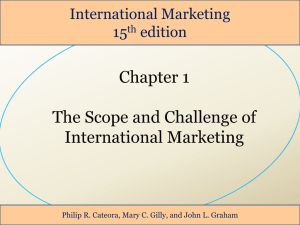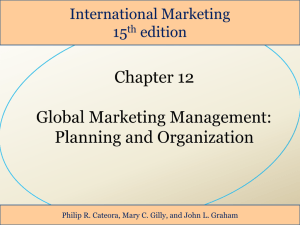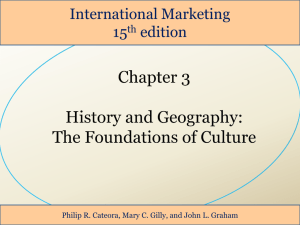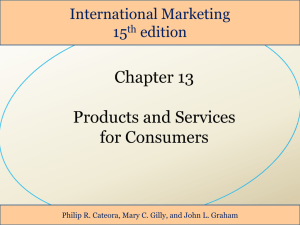International Marketing: Scope & Challenges
advertisement
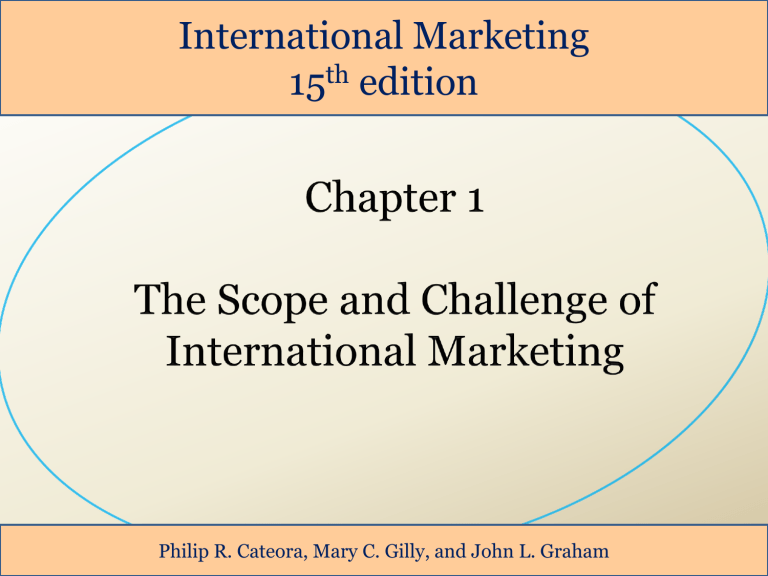
International Marketing 15th edition Philip R. Cateora, Mary C. Gilly, and John L. Graham Events and Trends Affecting Global Business • • • • 1 The rapid growth of the World Trade Organization (WTO) and NAFTA and EU The trend toward the acceptance of the free market system among developing countries in Latin America, Asia, and Eastern Europe The burgeoning impact of the Internet, mobile phones, and other global media on the dissolution of national borders The mandate to properly manage the resources and global environment for the generations to come Roy Philip 2 Internationalization of U.S. Business • • • 1 Foreign companies are here to stay in the U.S. and compete with U. S. companies The great worldwide acquisitions both by U. S. and foreign companies Global markets are a necessity – – – – Foreign earnings a higher percentage of profits Multinationals outperform domestic firms Global value increased through global diversification Intensifying domestic competition Roy Philip 3 International Marketing • • 1 International marketing is defined as the performance of business activities designed to plan, price, promote, and direct the flow of a company’s goods and services to consumers or users in more than one nations for a profit. The difference is the “environment” – Competition, legal restraints, government controls, weather, fickle consumers, economic conditions, technological constraints, infrastructure concerns, culture, and political situations. Roy Philip 4 The International Marketing Task 1 Exhibit 1.3 Roy Philip 5 Self-Reference Criterion (SRC) • • 1 Self-Reference Criterion (SRC) is an unconscious reference to one’s own cultural values, experiences, and knowledge as a basis for decision. Risk of SRC: – – Prevent you from becoming aware of cultural differences Influence the evaluation of the appropriateness of a domestically designed marketing mix for a foreign market Roy Philip 6 Cross-Cultural Analysis 1 1. Define business problem or goal in homecountry cultural traits, habits, or norms 2. Define business problem or goal in foreigncountry cultural traits, habits, or norms through consultation with natives of target country 3. Isolate the SRC influence and examine it carefully to see how it complicates the problem 4. Redefine the problem without SRC influence and solve for the optimum business goal situation Roy Philip 7 International Marketing Involvement - Stages 1 No Direct Infrequent Foreign Foreign Marketing Marketing Global Marketing Regular Foreign International Marketing Marketing Roy Philip 8 No Direct Foreign Marketing – Reactive • Products “indirectly” reach foreign markets • • • • • 1 Trading companies Foreign customers who contact firm Domestic wholesalers/distributors Web orders Foreign orders stimulate a company’s interest to seek additional international sales Roy Philip 9 Infrequent Foreign Marketing – Reactive • Caused by temporary surpluses – • 1 Sales to foreign markets are made as goods become available Firm has little or no intention of maintaining continuous market representation • Foreign sales activity declines and is withdrawn when domestic demand increases Roy Philip 10 Regular Foreign Marketing – Proactive 1 • Dedicated production capacity for foreign markets • Strategy: – Firm employs domestic or foreign intermediaries – Uses its own sales force or sales subsidiaries • Products are adapted for foreign markets as domestic demand grows • Firms depend on profits from foreign markets Roy Philip 11 International Marketing – Proactive 1 • Fully committed and involved in foreign markets and international activities • Production takes place on foreign soil earning firms the MNC (Multinational Corporation) title • Fedders being “proactive:” – Looked to Asia for future growth after stymied U.S. sales – Designed new types of air conditioner unit for the Chinese market – Plan to introduce new product in the U.S! Roy Philip 12 Global Marketing – Proactive 1 • The firm sees the world as one market! • Market segmentation is now defined by income levels, usage patterns, or other factors that span the globe • More than half of its revenues come from abroad • The firm has a global perspective Roy Philip 13 Global Market Orientation 1 • This orientation entails operating as if all the country markets in a company’s scope of operations (including the domestic market) were approachable as a single global market and standardizing the marketing mix where culturally feasible and cost effective. • Depending on the product and market, firms may pursue a global market strategy for one product (global market orientation – P&G diapers) but a multidomestic strategy for another product (international market orientation = P&G detergents). Roy Philip 14
